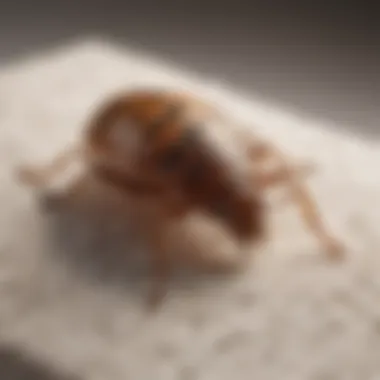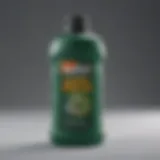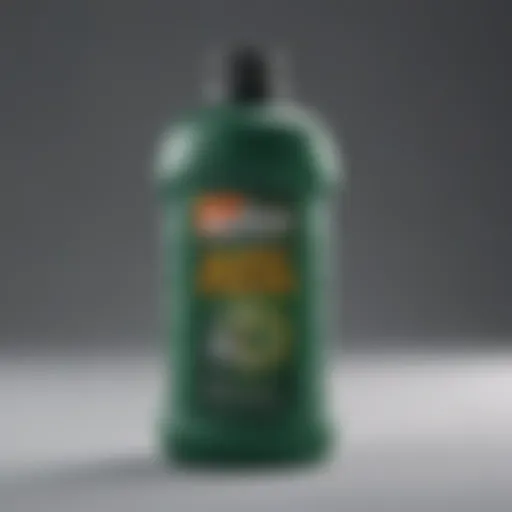Effective DIY Bed Bug Treatments: A Comprehensive Guide


Preventive Pest Control Strategies
House Exterior Protection
When aiming to prevent pest infestations in your home, it is crucial to start with securing the exterior of your house. To effectively bolster your defenses, consider implementing these recommended tips for sealing cracks, clearing debris, and practical ways to deter pests from entering your living space.
Yard Maintenance
Maintaining a well-kept yard plays a significant role in pest control. Explore essential yard care routines and discover effective methods for keeping your outdoor space pest-free. By following these simple yet strategic approaches, you can mitigate the risk of pest infestations from infiltrating your yard.
Indoor Cleanliness
Experts emphasize the importance of immaculate indoor environments to deter pests from establishing residency in your home. Learn expert cleaning tips and techniques that will aid in creating a pest-resistant indoor setting. Maintaining high standards of cleanliness is a fundamental step in preventing unwelcome pests in your living space.
Garbage Disposal
Efficient waste management and garbage disposal are paramount in pest control. Understand the significance of proper garbage disposal methods in deterring pests from congregating near your home. By adopting effective waste disposal practices, you can diminish the likelihood of attracting unwanted pests to your property.
Other Pest Prevention Strategies
Safeguarding your home against pests entails innovation. Intriguing methods exist to fortify your household against unwanted intruders. Explore diverse techniques and approaches to further fortify your residence from potential pest invasions.
Understanding Bed Bugs
Introduction to Bed Bugs
Physical Characteristics of Bed Bugs
The physical characteristics of bed bugs play a crucial role in their identification and control. These nocturnal insects are flat, oval-shaped, and reddish-brown in color with a size range of approximately 4 to 5 mm. Their small size and ability to hide in tiny crevices make them challenging to detect and eliminate, emphasizing the need for thorough treatment methods. Despite not having wings, bed bugs can move swiftly across various surfaces, including beds, furniture, and walls. This agility enables them to quickly infest new areas, necessitating comprehensive eradication measures. Understanding the physical attributes of bed bugs aids in recognizing their presence, allowing individuals to take prompt action to address infestations effectively.
Behavior Patterns of Bed Bugs


The behavior patterns of bed bugs are centered around their feeding habits and nocturnal activities. These pests are attracted to warm-blooded hosts, such as humans, for blood meals, which they typically obtain at night while their targets are asleep. Bed bugs inject an anesthetic and anticoagulant when feeding, ensuring their feeding process remains unnoticed by hosts. This stealthy behavior contributes to the challenge of early detection, as individuals may not realize they have been bitten until noticeable symptoms arise. Additionally, bed bugs have a remarkable ability to reproduce rapidly, with female bed bugs laying hundreds of eggs in their lifetime. This reproductive rate underscores the urgency of addressing bed bug infestations promptly to prevent population growth and further spread. By understanding the behavior patterns of bed bugs, individuals can tailor their treatment approaches to disrupt their feeding cycles and effectively reduce infestation levels.
Natural Remedies
In the realm of DIY bed bug treatments, natural remedies play a crucial role, offering individuals an effective and eco-friendly solution to combat infestations. These remedies not only provide a safer alternative to chemical treatments but also align with a sustainable approach to pest control. By incorporating natural remedies into bed bug treatment plans, individuals can address infestations while prioritizing the well-being of their household and the environment. In this article, we delve into the significance of natural remedies and explore their specific benefits and considerations.
Essential Oils
Lavender oil for repelling bed bugs
Lavender oil stands out as a prominent natural solution for repelling bed bugs due to its potent fragrance that deters these pests effectively. The key characteristic of lavender oil lies in its aromatic properties, which bed bugs find repulsive, leading them to avoid areas treated with this oil. This makes it a popular choice in DIY bed bug treatments as it offers a natural and pleasant-smelling alternative to traditional insecticides. Despite its efficacy in repelling bed bugs, one downside of lavender oil is that it may require frequent reapplication to maintain its effectiveness.
Tea tree oil for bed bug control
Tea tree oil is known for its antimicrobial and insecticidal properties, making it a valuable tool for bed bug control. The key characteristic of tea tree oil is its ability to disrupt the bed bugs' nervous system, ultimately leading to their demise. This makes it a beneficial choice for individuals seeking a natural and potent solution to combat bed bug infestations without resorting to harsh chemicals. A unique feature of tea tree oil is its versatility, as it can be used in various forms such as sprays, lotions, or diffusers. However, one should be cautious with tea tree oil as it can be toxic if ingested and may cause skin irritation in some individuals.
Diatomaceous Earth
Diatomaceous earth serves as a powerful natural remedy against bed bugs, thanks to its mechanical action that dehydrates and kills these pests. The key characteristic of diatomaceous earth lies in its abrasive texture, which penetrates the bed bugs' exoskeleton, leading to their desiccation. This makes it a popular choice for those seeking a non-toxic yet effective method to eliminate bed bugs. One unique feature of diatomaceous earth is its long-lasting residual effect, which can continue to combat bed bugs for an extended period once applied. However, its application requires precision to ensure thorough coverage and effectiveness in controlling infestations.
Mechanism of action against bed bugs
When diatomaceous earth comes into contact with bed bugs, its abrasive particles adhere to the insects' exoskeleton, causing damage and leading to dehydration. This mechanism of action effectively targets bed bugs' outer protective layer, ultimately resulting in their demise. A key advantage of this natural method is its non-toxic nature, making it a safe option for households with children and pets. However, one must exercise caution during application to prevent inhalation of the fine particles, which can irritate the respiratory system.
Application methods
The application of diatomaceous earth against bed bugs involves a meticulous process to ensure optimal results. The key characteristic of this method is its strategic placement in areas where bed bugs are likely to traverse, such as along baseboards, behind furniture, and near bed frames. By applying diatomaceous earth in a continuous and fine layer, individuals can create a barrier that effectively traps and eliminates bed bugs. An advantage of this application method is its versatility, as diatomaceous earth can be used in various forms such as powder or spray, offering flexibility in targeting different infestation levels and areas. However, care must be taken to reapply the powder periodically to maintain its efficacy over time.
Home Treatments
Home treatments play a crucial role in effectively addressing bed bug infestations. In the context of this article on DIY bed bug treatments, focusing on home-based solutions offers individuals practical and efficient methods to combat these pesky insects. Home treatments not only provide a cost-effective approach but also empower individuals to take control of their living spaces in a proactive manner. By incorporating home treatments into their pest management strategies, individuals can effectively tackle bed bug infestations and safeguard their homes.


Vacuuming and Steam Cleaning
Effectiveness in eliminating bed bugs
The effectiveness of vacuuming and steam cleaning in eliminating bed bugs cannot be overstated. These methods play a pivotal role in eradicating bed bugs from various surfaces and environments within homes. By using a vacuum cleaner with strong suction power and steam cleaning equipment, individuals can effectively capture and eliminate bed bugs at different stages of development. The thoroughness of vacuuming and steam cleaning ensures that bed bugs hiding in carpets, upholstery, and other hard-to-reach areas are targeted and removed, contributing significantly to reducing the bed bug population in an infested area.
Targeting hidden bed bug locations
Targeting hidden bed bug locations is a key aspect of home treatments to combat infestations effectively. Bed bugs are known to hide in crevices, cracks, and other hard-to-detect areas, making it challenging to eliminate them completely. By focusing on targeting these hidden locations during vacuuming and steam cleaning processes, individuals can disrupt the bed bug's hiding spots and prevent infestations from spreading further. This strategic approach not only helps in the immediate removal of bed bugs but also contributes to long-term prevention by addressing potential hiding spots where bed bugs might thrive.
Encasements and Clutter Reduction
The utilization of mattress encasements and implementing clutter reduction strategies play vital roles in home treatments against bed bugs.
Benefits of mattress encasements
Mattress encasements act as protective barriers that prevent bed bugs from infesting mattresses and box springs. By encasing these items with specially designed covers, individuals create a barrier that traps bed bugs inside and prevents them from feeding on humans during the night. The benefits of mattress encasements include not only protecting individuals from bed bug bites but also aiding in the detection of bed bugs. Moreover, mattress encasements are relatively easy to install and maintain, offering a practical solution for bed bug prevention and management.
Organizational tips to reduce bed bug hiding spots
Implementing organizational tips to reduce bed bug hiding spots is essential in creating an environment less favorable for bed bugs to thrive. Clutter provides ample hiding spots for bed bugs to breed and multiply, making it essential to declutter living spaces to minimize potential infestation areas. By organizing and decluttering bedrooms, living rooms, and storage areas, individuals can reduce the number of hiding spots available to bed bugs, thus making it easier to detect and monitor their presence. Additionally, maintaining a clean and organized living space enhances the effectiveness of other home treatment methods, facilitating a comprehensive approach to combating bed bug infestations.
DIY Sprays and Traps
In the realm of DIY bed bug treatments, the utilization of sprays and traps plays a pivotal role in combating infestations effectively. DIY sprays and traps are essential components of this article as they offer practical and immediate solutions for dealing with bed bugs. When addressing bed bug issues independently, individuals can benefit greatly from the specific elements of these sprays and traps, understanding the importance of early intervention in tackling infestations. The benefits of DIY sprays and traps in this context include cost-effectiveness, user-friendliness, and the ability to target specific areas where bed bugs hide, ensuring a comprehensive approach to eradication.
Homemade Bed Bug Sprays
Ingredients for a natural bed bug spray
The choice of ingredients for a natural bed bug spray is a crucial aspect within the realm of DIY treatments. These ingredients contribute significantly to the overall effectiveness of the spray in combating bed bugs. Lavender oil, for example, stands out as a popular choice due to its powerful repelling properties. Its unique fragrance not only deters bed bugs but also serves as a natural and safe alternative to harsh chemicals. The advantages of using lavender oil in bed bug sprays lie in its non-toxic nature, pleasant scent, and proven efficacy in repelling these pests.


Application instructions
The application instructions for DIY bed bug sprays are equally vital to achieving successful outcomes. Proper application techniques ensure thorough coverage of infested areas, maximizing the spray's effectiveness in eliminating bed bugs. Following precise instructions on where and how to apply the spray is key to targeting bed bug hotspots effectively. Moreover, the unique feature of DIY bed bug spray instructions lies in their simplicity and accessibility. By providing clear and easy-to-follow guidelines, individuals can apply the spray confidently, even without professional assistance, thus empowering them to take control of the situation.
Effective Traps
Types of traps for monitoring bed bug activity
When it comes to monitoring bed bug activity, the choice of traps plays a critical role in DIY treatments. Different types of traps offer varying benefits in detecting and tracking bed bug movements. From adhesive traps to interception devices, each trap has its unique characteristics that contribute to the overall goal of identifying bed bug presence. Understanding the advantages and disadvantages of each trap type helps individuals select the most suitable option for their specific situation, enhancing the efficiency of their monitoring efforts.
Placement tips for maximum efficiency
The placement of traps to achieve maximum efficiency is an essential consideration in DIY bed bug treatments. Strategic placement in areas with high bed bug traffic, such as near beds and furniture, increases the likelihood of trapping these pests. The key characteristic of proper trap placement lies in creating optimal conditions for attracting and capturing bed bugs. By following specific tips for placement, individuals can enhance the performance of traps and gain valuable insights into the extent of their infestation. The unique feature of these placement tips lies in their ability to improve the overall effectiveness of traps, providing a proactive approach to monitoring bed bug activity.
Preventive Measures
Bed Bug Prevention Strategies
Tips to avoid bed bug infestations
When it comes to averting bed bug infestations, implementing practical tips can be a game-changer. Tips such as regularly inspecting second-hand furniture, avoiding clutter in living spaces, and being cautious when traveling can significantly reduce the likelihood of bed bug encounters. The key characteristic of these tips lies in their simplicity and effectiveness. They are practical, easy to implement, and align perfectly with the goal of this article, which is to empower individuals with actionable strategies for bed bug control.
Creating a bed bug-proof environment
Creating a bed bug-resistant environment involves making smart choices in furniture selection, utilizing bed bug-proof encasements, and maintaining a tidy living space. This practice is a popular choice for homeowners seeking long-term protection against bed bugs. The unique feature of this strategy is its holistic approach; by creating barriers that deter bed bugs from thriving, individuals can safeguard their homes without relying solely on reactive treatments. While the upfront effort may require some investment, the long-term advantages, including peace of mind and reduced likelihood of infestations, make it a worthwhile endeavor.
Regular Inspections
Incorporating regular inspections is vital in the fight against bed bugs. By establishing a routine to check for early signs of infestation, individuals can nip potential problems in the bud, preventing costly and extensive treatments down the line. The frequency of checking for bed bugs should be consistent, ideally at least once a month, to catch any emerging issues early on.
Frequency of checking for bed bugs
Regular checks contribute significantly to maintaining a pest-free environment. Their key characteristic lies in their ability to catch bed bug infestations in their initial stages, where they are more manageable and less disruptive. Consistent inspections are a beneficial choice for this article as they promote vigilance and prompt action, two crucial elements in effective bed bug control. The unique feature of frequent inspections is their role in early detection, enabling homeowners to address infestations before they spiral out of control.
Areas to focus during inspections
When conducting inspections, focusing on key areas that bed bugs are likely to inhabit is essential. Areas such as seams and folds in mattresses, cracks in furniture, and behind wallpaper are common hiding spots for bed bugs. By paying attention to these specific areas, individuals can increase the likelihood of discovering early signs of infestation. The key characteristic of this practice is its detailed approach, targeting known bed bug habitats with precision. While thorough inspections may be time-consuming, the advantages of uncovering infestations early on far outweigh the disadvantages, making this a crucial aspect of effective bed bug control in this article.



